Making turbocharged versions of the new 2.2 liter four-cylinder engines was not part of the anyone’s plan while those powerplants were being developed. Fortunately, the engines were tough and well-engineered, and took well to turbocharging. The first versions had no intercooler but were still nearly 50% more powerful than the non-turbo versions; these had relatively few changes, but once the intercooler was added, Chrysler engineers toughened up the bottom end of the engine, because they were looking at moving from around 90-100 horsepower to 174.

The turbos of the 1980s and 1990s were amazingly trouble-free, for the most part, given that the people designing them generally had no experience with forced induction. The head of engine tuning, Pete Hagenbuch, told me, “We had no one in-house who knew much more than the very basics. It was pretty much learn as you go. The electronics folks at Chrysler were not any better off...We learned a lot about turbocharging and, yes, the 2.2 responded to everything we did.” Despite this, Chrysler’s Turbo IV setup with was innovative enough that modern turbos follow in their path.
All of Chrysler’s forced induction engines, until the Neon SRT and then the Hellcat, used the same family of four cylinder engines. (The company’s diesels were outsourced.) They all had multiple port fuel injection, and for a time were Chrysler’s only engines with that setup.
Cost estimator Warren Steele remembered that they had major problems in development, including turbo bearing failures during heat tests. Engineers had to create water cooling jackets, at a hefty cost in time and money.
The 1980s had two basic Mopar designs: Turbo I and Turbo II. The Turbo I mainly added the multiple port injection and a turbocharger; that provided 142 horsepower in 1984, when it was launched on the 2.2 liter engine. A longer-stroke version, displacing 2.5 liters, came later, with similar power ratings but better low-end torque; these were used on the minivans, which were not too heavy on their own but could be loaded up with seven people and their luggage.

The Turbo II, only used on the 2.2 engines, added a charge air cooler (which we will call an intercooler, as most people do); these produced 174 horsepower. Starting in 1988, they had black manifolds. Turbo III and Turbo IV setups came in the 1990s. Other setups included Shelby’s early intercooled version—basically the Chrysler Turbo II, but without a beefed up bottom end—and the M4S concept car. There was a Chrysler TC by Maserati using Cosworth heads with a Turbo II setup, as well. The Turbo I and Shelby Turbo IIs had cast crankshafts; the others all had forged cranks.
As you may have guessed, the Turbo I was by far the more common engine; indeed, production was quite high from 1984 to 1988. The following numbers are from the Trenton Engine plant, courtesy of “superduckie:”
| Model Year | Turbo I | Turbo II |
|---|---|---|
| 1984 | 90,169 | |
| 1985 | 199,995 | |
| 1986 | 214,996 | |
| 1987 | 203,685 | 6,671 |
| 1988 | 106,906 | 10,017 |
| 1989* | 172,376 | 13,042 |
* Turbo I was 2.2 liters through the 1988 model year, and switched to 2.5 liters for 1989 vehicles. 1989 was also the first year the turbocharged engine was used in minivans, which certainly needed the extra power. 1989 production numbers may be incomplete (below the actual totals).
Though Chrysler set its sights on turbochargers, lead engine performance man Pete Hagenbuch thought superchargers were the way to go; he believed supercharging was ideal for street engines, while turbos were best for racing. He never got authorization to build even a test supercharged 2.2, though. Pete argued that turbochargers produced too much heat for normal driving; he believed he could overcome friction losses on superchargers within six months.
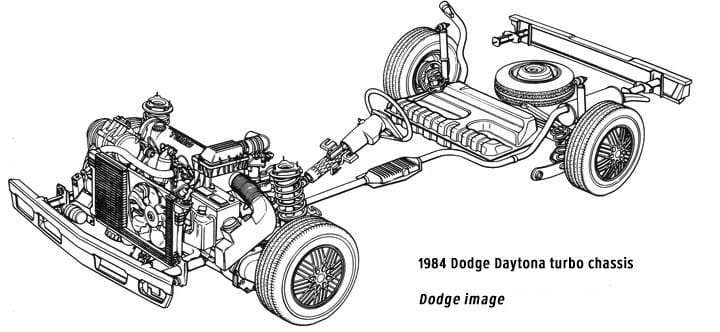
The first car to get the turbocharged engine was the brand new, premium four-cylinder sports car, the Dodge Daytona—accompanied by a Chrysler Laser sibling for a few years.
The 2.2 liter engine was developed and built entirely by Chrysler as a clean-sheet design, sharing a few measurements with the slant six to cut tooling costs. Engineering started in the mid-1970s for a 2.0 liter overhead cam iron-block four-cylinder to power a car based on the upcoming Chrysler Horizon; when the Reliant and Aries were green-lighted, the engineers expanded the cylinder size by 10% to compensate for the new cars’ greater weight. At this point, they were not considering forced induction or a long stroke version.
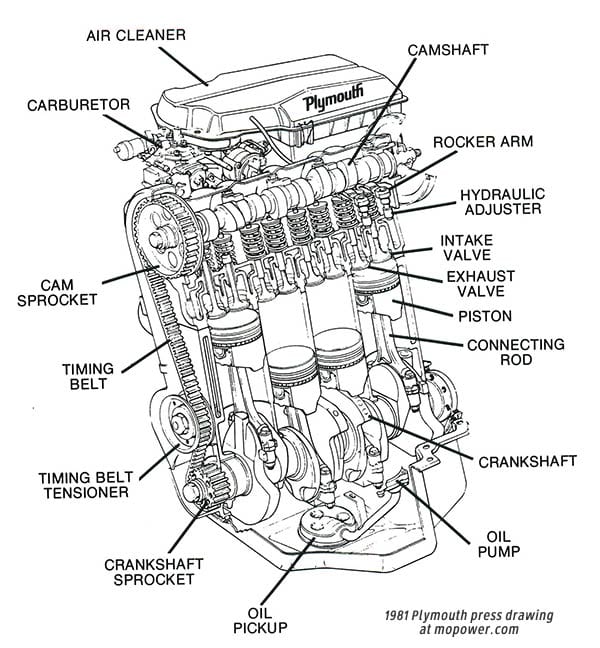
The intake and carburetor were warmed with exhaust gases. The engineers placed the carburetor and other components in a way that made it easier to install the new engine into Horizons and Omnis, whose base engine was a Volkswagen four-cylinder. Production started in Trenton, Michigan for the 1981 Reliant and Aries, taking the place of a long-abandoned big-block line; the factory had computer-controlled test stands, one where the stand powered the engine to check the valve gear and such, and one where the engine ran by itself.
The power ratings for the 1981 cars were 84 horsepower and 111 pound-feet of torque, with a two-barrel carburetor; compare that to the 3.7 liter slant six, which produced, in 1978, 110 horsepower and 180 pound-feet of torque with a two-barrel. The 2.2 was far lighter, and came with 16 horsepower before any modifications—though it could not come close to the slant six’s torque without help.

For 1983, revised intake and exhaust ports and higher compression brought output to a more reasonable 94 horsepower and 117 pound-feet of torque, with variants producing 100-horsepower and even 107-horsepower variants. The one millionth 2.2 was built just three years after production started.

In some of the 1984 cars, a single fuel injector replaced the carburetor, with output at 99 horsepower and 121 pound-feet; the Shelby version kept the carburetor, and was tuned for the highest output of any naturally aspirated 2.2—107 hp at 5,600 rpm. That was enough to provide 0-60 times of 8.7 seconds (beating the Volkswagen GTI by a full second) in the 1984 Dodge Omni GLH, in one magazine’s tests.
Chrysler’s first turbocharged engine went into the 1984 Dodge Daytona, the second American front-drive turbo car ever. Output was 142 horsepower at 5,600 rpm and 160 lb-ft of torque at 3,200 rpm, quite respectable compared to the old slant six; the Mitsubishi 3-liter V6 had similar numbers. Fuel economy was superior to the Mitsubishi V6, and surprisingly close to the base four-cylinder.
Chrysler used Garrett Research’s T-3 turbocharger, which had a built-in, mechanically-controlled wastegate and peak 7.2 pounds per square inch (psi) of boost. The wastegate acted on the difference between throttle body vacuum and compressor output, bypassing the turbine when pressure got too high. The housing was iron, though the turbine was aluminum.
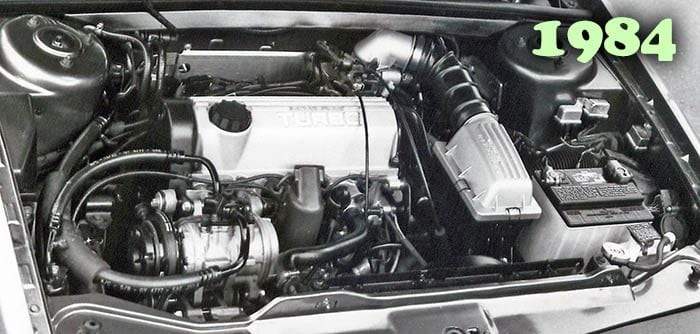
Pete Hagenbuch was head of production engine tuning at the time; he had to fight to get executives to approve premium fuel, but in the end, it made a substantial impact on power output and fuel economy. Even so, he insisted on using a detonation (knock) sensor, so customers would not destroy the engine by using lower-octane fuel. If the fuel started to detonate before the spark, it retarded the ignition timing to compensate.
The fuel injection system, engineered and made by Chrysler, had very high fuel pressure compared with past cars, and fuel leaks were a problem as the cars aged.

Compression was lowered by using special pistons, which for performance reasons were lightweight and strut-less. To help the engine handle the added power, they beefed up the stronger valves, springs, rockers, rods, and cam, using select-fit bearings and better rings; on top was a die-cast aluminum head cover, for looks. Pete Hagenbuch and Dick Winkles wanted a rounded top for better airflow, but the Daytona product team wanted a flat top with ribs for looks, and they won out. The effects on performance were probably small.
Mitsubishi was absolutely not involved in the design and engineering of the 2.2 or 2.2 turbo, aside from selling their turbochargers to Chrysler in later years.
The first engineer in charge of the Turbo II setup was Dick Winkles, who would later take charge of Viper engines; testing and final development started out in May 1985. Carroll Shelby’s 1986 Omni GLH-S ran an early intercooled engine with hardware and software work from Chrysler (Shelby’s operation was relatively small). Shelby’s version lacked the bottom-end toughening of the Chrysler version; torque on Shelby’s own intercooled engines was reduced somewhat, ostensibly for transmission durability. Chrysler’s version had a forged crank while Shelby used the Turbo I cast crank; Chrysler also used a one-piece intake. Both had the same rods, Mahle pistons, and larger injectors as the 1984-85 Turbo I engines.

The Turbo II was essentially a Turbo I with a charge air cooler (intercooler) and numerous changes to keep durability up to speed. The intercooler brought power up to 174 horsepower and 200 pound-feet of torque (remember, the old slant six peaked at 110 horsepower and 180 pound-feet). Reliability was dealt with by the forged crank, tubes between the cylinder bores at the top deck for cooling, and heavier-duty manual transmissions as part of the powertrain package. The Turbo II shared connecting rods with the 2.5 liter Turbo I engine (see next section); they were double weight sorted for balance.
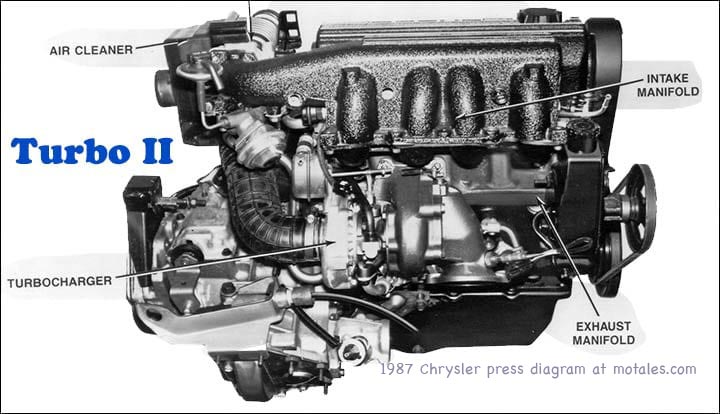
The intercooler (charge air cooler) increased peak power by dropping the air temperature by up to 120°F, so boost could peak at 12 psi rather than 7.2 psi. Colder air is denser air; denser air has more oxygen to burn, so more fuel can be injected. It was a matter of taking the same space in each cylinder and making it seem as though it was larger—adding more air and fuel.
The Turbo II was used on the 1987 Shelby Z; the 1988 Lancer ES (optional) and TC automatic (standard); and, finally, the 1989 Daytona Shelby and C/S, Shelby Lancer, LeBaron GTS, and LeBaron (optional). It was sturdy, powerful, and reliable, and provided surprisingly good fuel economy; many owners reported 30 mpg. EPA estimates were somewhat lower than the non-turbo cars, but owners reported higher economy in normal use.
In the 1989 cars, the 2.2 Turbo I (142 hp) was replaced by a 2.5 liter version to improve low-end torque. A car with this engine covered 10% more distance in the first five seconds than in the Turbo I. This was especially important with minivans, which for the first time had an option more powerful than the 2.6 liter Mitsubishi four-cylinder. The turbo 2.5 was a placeholder for V6 engines, but with a stick-shift, it made the minivan move quite well. With the three-speed automatic, due to inappropriate shift points, it was somewhat sluggish.

The 2.5 liter engine had counter-rotating balance shafts, a clever addition to an engine never meant to have them.

The turbo engines had a new block for 1989, with diagonal coolant passages drilled between cylinders for better cooling. There were also new aluminum-alloy pistons, with cast-in steel struts to control expansion; a dished crown to get the right compression ratio; and a high-hardness iron crank, which is not interchangeable with the 2.2 crank, because of clearance issues. Power output was 150 horsepower (at 4,800 rpm), with 180 pound-feet of torque. As with all Chrysler’s four-cylinder turbo engines, it required premium fuel, but a knock sensor made it forgiving of regular. The turbocharger assembly had some minor changes in the 2.5 for higher airflow, as well as a new oval (rather than round) air cleaner.
The Turbo IV was distinguished by its variable geometry turbocharger, developed by Chrysler and Garrett together. Dick Winkles, Kim Lyon, and Stuart Davis were deeply involved in this project, the last of Pete Hagenbuch’s long career. The Turbo II was to have the variable-geometry turbocharger, but it was not ready in time—it was not really ready in early Turbo IV cars, either.
The Turbo III was the most advanced system overall, but the Turbo IV (which appeared before the Turbo III) had the most advanced turbocharger; it was the first production vehicle with variable-nozzle technology (VNT), which increased boost at lower engine speeds and avoided turbo lag. The top horsepower rating was the same as in the Turbo II, while torque was somewhat higher (210 pound-feet); but the engine reached boost in half the time of the Turbo II, giving the engine a broader torque curve. It was smoother, too.
The VNT replaced the wastegate with a solenoid-driven actuator, which moved the vanes on computer command. One ring moved the 12 vanes, which pivoted around the turbine wheel, to adjust the flow of gases to the turbine.
Chrysler put in balance shafts to smooth the idle out (in 1990, all turbo 2.2s would have balance shafts), and coupled it with sequential multiple-port fuel injection—past engines splashed some fuel against closed valves. The package was rounded out with a new crankcase ventilation (PCV) system with a better oil separator.
The Turbo IV was only used in the Shelby CSX (not the CSX-T); the Chrysler LeBaron coupe and convertible; and one model of the Dodge Daytona. Early turbochargers could have issues with clogging; engineer Burke Brown said they fixed this by flipping the nozzles back and forth a few times whenever the system was started. By then the die was cast; and in any case customers wanted more holes in their engine, not more power.
In the 1980s, Chrysler took its around-100 horsepower four-cylinder engine and pushed it to 174 horsepower and 210 pound-feet of torque—all quite good for an engine never designed for such treatment. How could they top that?
The 1990s opened with a bang—the “Turbo III,” which added dual overhead cams, operating four valves per cylinder; all the other 2.2 and 2.5 liter engines had a single cam and two valves per cylinder.
The “T3” was only ever used in three cars, all of them quite impressive. The quickest of the three was the big Dodge Spirit R/T sedan, made in 1991 and 1992; the best-handling was the Dodge Daytona IROC R/T, made in 1992 and 1993; and the rarest may be the Stratus R/T, which was only sold in Mexico.

Generating 224 hp (6,000 rpm) from 2.2 liters, the T3 was thrilling; turbo lag and uneven acceleration were never so severe at Chrysler as on this engine, which shifted from the 2.2’s basic hundred-or-so horsepower to full-on-boost-madness almost instantly. Floor the gas pedal, feel the pause, and then shoot forward: that was life with the Spirit R/T. Peak torque was the same 210 pound-feet of torque, but now at 4,800 rpm. These numbers came with the original restrictive exhaust, often replaced by owners for greater power.
According to Ed Poplawski, they looked at using Maserati heads, with bucket tappets, before settling on Lotus Engineering to help design the heads. Some blamed Lotus for using overly-strong chrome-vanadium steel valve springs to prevent float at high revs, though redline was just 6,700 rpm; that led to a high tension on the timing belt. Failing to set the belt to that tension would result in a belt life of weeks; but a properly installed belt, assuming the tensioner was working properly, could last for tens of thousands of miles.
One engineer wrote that the issue was not the springs, but avoiding “tow roping,” or the timing belt going into negative tension, due to low valvetrain friction and the dual cams. When the exhaust valve rocker went over the nose of the cam, there was no friction to slow it down, causing the exhaust cam sprocket to go faster, cutting tension in the belt between the sprockets. The Neon would deal with the problem by having an automatic belt tensioner; other dual-cam four-cylinders used bucket tappets, which had more friction. The solution most companies settled on was a timing chain.
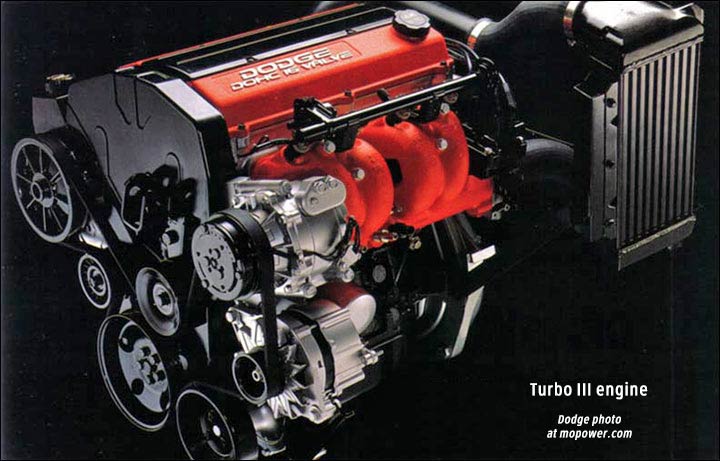
Development on the A-522 (Turbo III) project had started back in March 1985; the Turbo IV came out earlier, but the projects were numbered by when they started, not when they ended. It took longer to do the dual overhead cams, so the Turbo III came out after the Turbo IV, which mainly altered the turbocharger design.
As with Hemi engines, the spark plug was right at the center of the combustion chamber (T3 heads were a shallow pent-roof design). The pistons were forged aluminum, with scalloped tops to prevent damage if the timing belt broke.
Air pumping was far better than other 2.2s, largely due to the cross-flow porting, with the intake side facing front. Individual intake manifold runners, a 52 mm throttle body, divided ports, and large valves (1.4 inch intake, 1.28 inch exhaust) also helped; valves seated with a 45° contact and were set at a 29.5° included angle. Boost peaked at 11 psi. Injectors were mounted in the intake runners. Valve springs were made of chrome-vanadium steel; the equal-length cams were made from a common casting and driven by a 30-mm-wide glass-fiber-reinforced cogged belt with a manual tensioner. This belt tended to fail by stripping the cogs, rather than snapping.
Cams were made from a common casting and had equal lengths, set up alongside the valves to reduce the assembly height. The engine used the same connecting rods as the Turbo II, double weight sorted before assembly for accurate balance.

Internal changes to the turbocharger assembly were made to increase airflow, and the air cleaner was changed from round to oval in shape.
The engines were made in Trenton, Michigan.
The engine was styled with valve covers painted red and boasting a “wrinkle” finish, and chromed fuel rails and regulator, with a black plastic cover between the camshafts. The brushed aluminum nameplate boasted of the intercooler, DOHC design, and 16 valve engines.
Originally, iron plugs were put into the aluminum engine’s water jacket holes, which caused many 1991 heads to crack; that was fixed as soon as it was discovered, and a recall set up to replace them with aluminum plugs.

Someone appeared to do a DIY update on this valve cover
Performance was quite impressive for the day; the Spirit R/T, a five-passenger sedan with little “performance DNA,” could do 0-60 in under 6 seconds, bone stock, easily beating many V8-powered cars. Torque steer was a definite issue; power went from “almost none” to “wow” in a moment as the turbo suddenly started spinning up and the cylinders were shoved full of air/fuel mixture.
Chrysler replaced the mechanical wastegate control with computer control after the first model year. The engineers programmed in calibrated pressure limits, and the computer activated or shut off the turbine via the wastegate actuator solenoid. At higher pressures, a spring pushed on a rod to open the wastegate, allowing exhaust gases to leave without spinning the turbine. The new system allowed for short (ten-second) bursts of 9 psi boost, and output rose from 142 horsepower to 146.
Numerous other changes were made at this time, some as running changes (e.g. lightweight connecting rods, anti-drainback oil valve, and 11 mm head bolts); most were done for durability (high temperature timing belt, material added to the head and block at the oil transfer hole, a revised oil pump, and a late-launch 8-bolt flywheel. A water box was integrated to the bottom of the intake, and the intake valve surface was improved. Chrysler started testing a four-valve-per-cylinder version on an AWD Daytona with a 10 psi turbocharger and 225 horsepower at about this time.
The 1986 cars used new pistons and heads which burned fuel faster, which allowed wide-open-throttle spark timing to be backed off and reducing sensitivity to low octane. A new distributor had fewer parts. Reliability was improved with thicker head gaskets, valve covers designed to prevent splashing, new valve springs, longer intake and exhaust valves, better rod caps, and a common dipstick.

For the 1988 model year, a long-branch intake manifold, which included a tuning effect and better fuel-air ratio distribution, allowed for a more aggressive spark advance curve without detonation; when this was introduced, the old one was nicknamed the “log” manifold. The intake was used on both turbo setups. The charge air sensor on the Turbo I was replaced by computer programming; it stayed on the Turbo II.
A smaller, quicker-to-spool Mitsubishi turbo replaced the Garrett T03. This change resulted in higher torque (170 pound-feet) arriving at a lower engine speed, 2,400 rpm, on the Turbo I. The compression ratio dropped to 8.0:1.
For 1989, the 2.5 replaced the 2.2 as the Turbo I engine, and a new common block was used for all 2.2 and 2.5 engines. This block had stronger main bearing caps and supports. The long deck of the old 2.5 was replaced by shorter pistons.

1990 engines used a single board engine computer (SBEC) rather than a dual-board version. Engineers trying to chase down oil leaks tried a new stamped steel valve cover with a single-piece gasket. They also added balance shafts to the 2.2 liter turbo engines, used sintered metal intake and exhaust guides to improve lubrication, changed the pistons to improve pin support, and upgraded the water pump innards. The Turbo I was still used in the Lebaron, Daytona, Shadow, and Spirit, with manual transmissions; and in the Lebaron and Daytona automatics.
Other changes for the 1990 cars were a new air cleaner box, an integrated pressure bypass valve to vent turbocharger pressure on sudden throttle release, a better PCV oil separator, and a cleanable oil vapor element. Sequential fuel injection finally reached the Turbo I.
For 1991, Chrysler improved on the 2.5 Turbo I, adding low-speed boost and changes to fuel and timing control, bringing new highs of 152 horsepower and 211 lb-ft. The computer controls were faster, too.

The Turbo IV ended in 1991, the III in 1992; the 2.5 turbo was the sole survivor in the 1993 cars, and the “non-turbo” 2.2 had its final year in the 1994 model year (the “non-turbo” 2.5 lasted until the end of the 1996 Dodge Dakotas, and was replaced by an AMC engine). The turbo engines were replaced by Mitsubishi V6 engines. Outside North America, First Auto Works of Changchun made the old 2.2 and 2.5 liter engines from 1990 until after 2000.
The next Chrysler turbo engines would be based on a new engine launched in 1994, for the 1995 Neon, displacing 2.0 liters but rated at 132 horsepower with one cam and 150 horsepower with two. Turbochargers were brought back for the PT Cruiser and Neon SRT4—but that’s another story.
All the turbos (and the Chrysler non-turbo four-cylinders of the time) were noninterference designs, meaning that the valves could not interfere with the pistons even if the timing belt snapped.
The two versions of the engine, 2.2 and 2.5 liter, started with different cast-iron blocks. they shared siamesed bores, a short-skirt design, an internal oil pump, and a partial open deck. Eventually a common block replaced the separate ones.
Turbochargers are spun by the exhaust, with a wastegate that lets the exhaust bypass the turbocharger when the extra power isn’t needed or when pressures are too high—when there is too much boost. Because more exhaust volume provides more boost, putting the engine under load added boost. Starting after 1984, the engine computer could adjust the wastegate; the computer monitored engine speed (rpm), the knock sensor, wheel speed, intake temperature, battery temperature, throttle position, exhaust oxygen, coolant temperature, manifold pressure, and air conditioner and electric fan status, adjusting boost, fuel, and spark as needed. (In 1984 it was a purely mechanical setup.) Up to ten seconds of overboost was allowed.
Chrysler did not use airflow sensors because engineers felt they were too expensive and unreliable (the latter, based on problems with an earlier fuel injection system); instead, they measured manifold pressure or vacuum and ambient air pressure, and computed airflow from that. Load was also computed.
The turbocharger was cooled by oil (around the bearings) and antifreeze, with ambient air cooling as well.
Lotus’ Michael Royce wrote to me when I was at Allpar to describe three development programs run by Lotus Engineering. Chrysler Vice President of Engineering Robert Sinclair—who led the creation of the 1960 Valiant—signed the contract for these in March 1985.
One was for a 16-valve turbocharged engine, program A-522, which became the Turbo III. Another was for a 16-valve, naturally aspirated 2.5 liter engine, which would resolve the engine’s breathing issues and make it smoother, with a higher redline, providing roughly 140 horsepower. This did work out, but was killed due to budget issues in mid-1986. The engine was running in a Sundance or Shadow with a manual transmission, and in emissions testing, when it was dropped.
They dropped the AWD Dodge Daytona program in late 1987, again due to budget shortfalls, though the car reportedly performed and handled as well as the Audi Quattro.
The Turbo III, a troublesome and presumably expensive engine, was not dropped and made it to fruition; admittedly, it had the highest power potential.
STLA jumps into robotaxis with Uber, Nvidia, Foxconn
Ford, Tesla, Stellantis dominate recalls this week
Toledo Jeep plant on “emergency status”
Copyright © 2021-2025 Zatz LLC • Chrysler / Mopar car stories and history.
YouTube • Editorial Guidelines • Videos